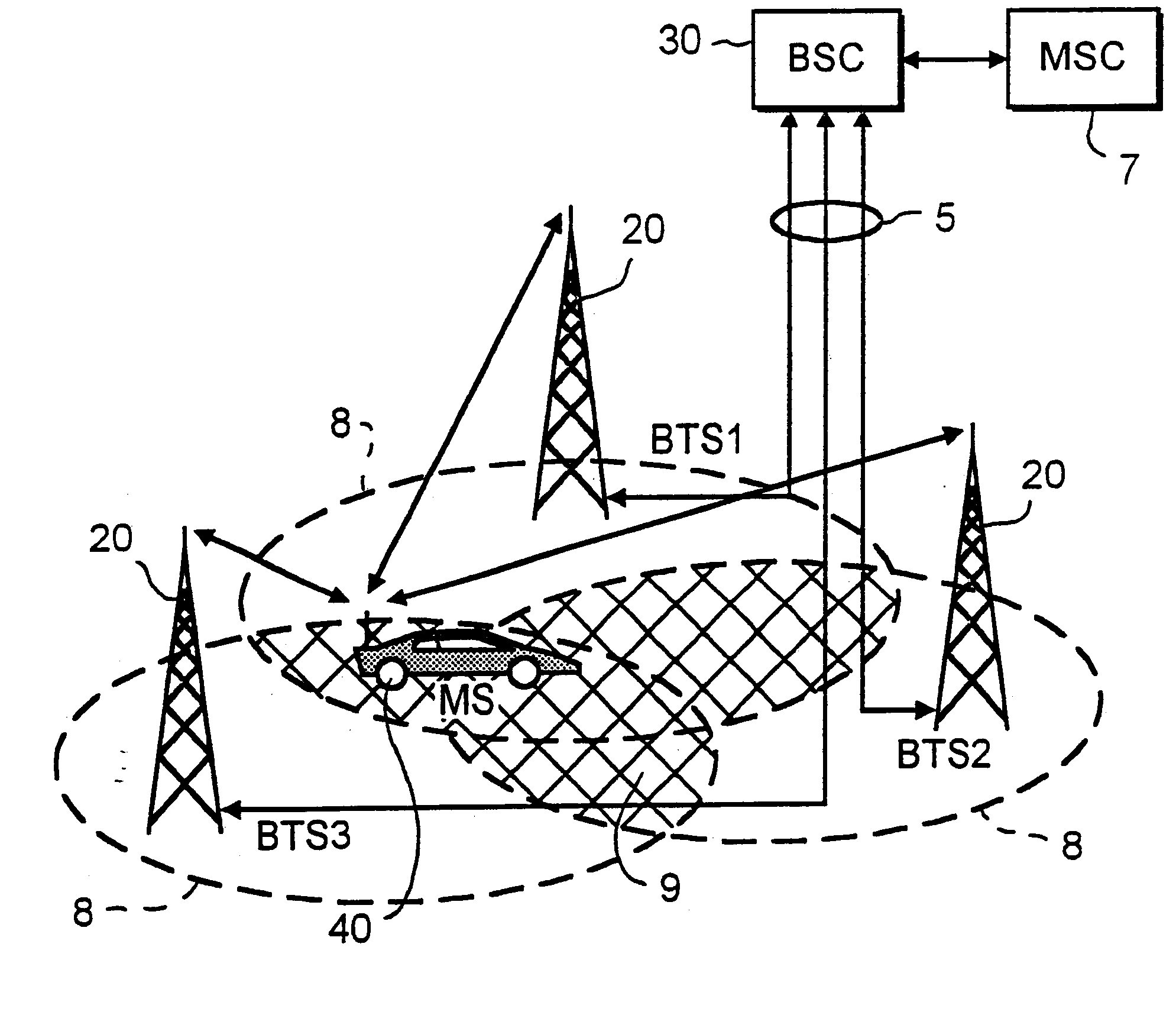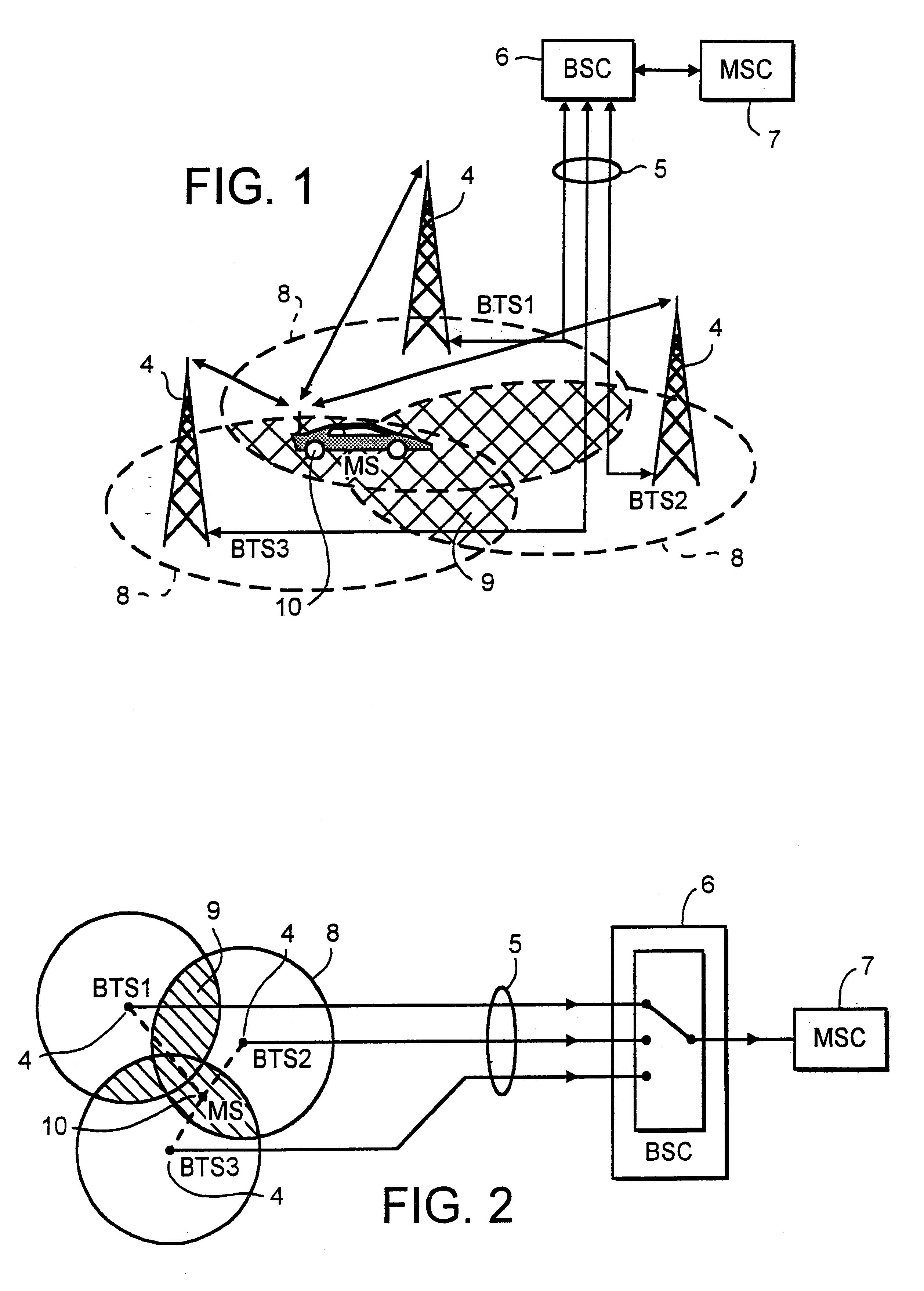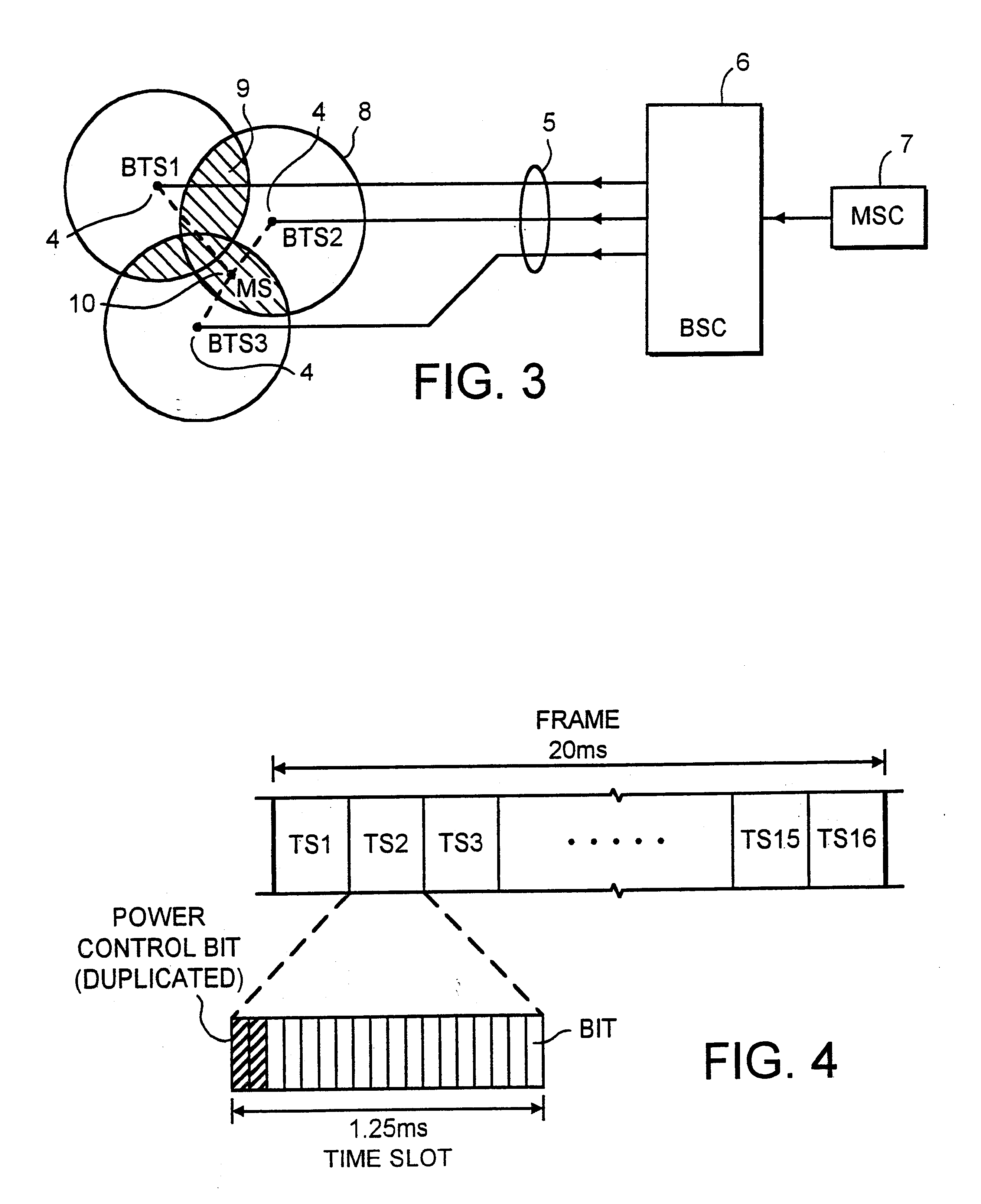[0020]According to a first aspect of the present invention there is provided a cellular mobile communications network including: a candidate
base transceiver station identifying unit operable, when a mobile station of the network is capable of receiving a downlink signal from a plurality of base
transceiver stations of the network, to identify at least two different candidate
base transceiver station selections. Each such selection specifying one or more base
transceiver stations of the plurality for possible use in transmitting a subsequent such downlink signal to the mobile station. A network interference determining unit operable, for each of the candidate selections, to produce a measure of the network interference that would be caused by the
base transceiver station(s) specified in that candidate selection transmitting the subsequent downlink signal to the mobile station. A
decision unit operable, in dependence upon the network-interference measures, to decide which one of the candidate selections is to be used to transmit the subsequent downlink signal to the mobile station, so as to tend to reduce network interference arising from the transmission of that downlink signal.
[0021]According to a second aspect of the present invention there is provided a mobile station, for use in a cellular mobile communications network, including: a candidate base transceiver station identifying unit operable, when the mobile station is capable of receiving a downlink signal from a plurality of base transceiver stations of the network, to identify at least two different candidate base transceiver station selections. Each such candidate selection specifying one or more base transceiver stations of the plurality for possible use in transmitting a subsequent such downlink signal to the mobile station. A network interference determining unit operable for each of the candidate selections, to produce a measure of the network interference that would be caused by the base transceiver station(s) specified in that selection transmitting the subsequent downlink signal to the mobile station. A
decision unit operable, in dependence upon the network-interference measures, to decide which one of the candidate selections should be used to transmit the subsequent downlink signal to the mobile station, so as to tend to reduce network interference arising from the transmission of that downlink signal.
[0022]According to a third aspect of the present invention there is provided a base transceiver station, for use in a cellular mobile communications network, including: A candidate base transceiver station identifying unit operable, when a mobile station of the network is capable of receiving a downlink signal from a plurality of base transceiver stations of the network including the base transceiver station, to identify at least two different candidate base transceiver station selections. Each such candidate selection specifying one or more base transceiver stations of the plurality for possible use in transmitting a subsequent such downlink signal to the mobile station. A network interference determining unit operable, for each of the candidate selections, to produce a measure of the network interference that would be caused by the base transceiver station(s) specified in that selection transmitting the subsequent downlink signal to the mobile station. A
decision unit operable, in dependence upon the network-interference measures, to decide which one of the candidate selections should be used to transmit the subsequent downlink signal to the mobile station, so as to tend to reduce network interference arising from the transmission of that downlink signal.
[0023]According to a fourth aspect of the present invention there is provided a base station controller, for use in a cellular mobile communications network, including: A candidate base transceiver station identifying unit operable, when a mobile station of the network is capable of receiving a downlink signal from a plurality of base transceiver stations of the network, to identify at least two different candidate base transceiver station selections. Each such candidate selection specifying one or more base transceiver stations of the plurality for possible use in transmitting a subsequent such downlink signal to the mobile station. A network interference determining unit operable, for each of th e candidate selections, to produce a measure of the network interference that would be caused by the base transceiver station(s) specified in that selection transmitting the subsequent downlink signal to the mobile station. A decision unit operable, in dependence upon the network-interference measures, to decide which one of the candidate selections to use to transmit the subsequent downlink signal to the mobile station, so as to tend to reduce network interference arising from the transmission of that downlink signal.
[0024]According to a fifth aspect of the present invention there is provided a communications method for use in a cellular mobile communications network, including: when a mobile station of the network is capable of receiving a downlink signal from a plurality of base transceiver stations of the network, identifying at least two different candidate base transceiver station selections, each such selection specifying one or more base transceiver stations of the plurality for possible use in transmitting a subsequent such downlink signal to the mobile station; producing, for each of the candidate selections, a measure of the network interference that would be caused by the base transceiver station(s) specified in that selection transmitting the subsequent downlink signal to the mobile station; and deciding, in dependence upon the network-interference measures, which one of the said candidate selections to use to transmit that subsequent downlink signal to the mobile station, so as to tend to reduce network interference arising from the transmission of that downlink signal.
[0029]According to an eighth aspect of the present invention there is provided a mobile station, for use in a cellular mobile communications network, including: a
transmitter for transmitting uplink signals to a base transceiver station of the network and a signal
information processor connected to the
transmitter and operable, during a soft hand-off operation involving a plurality of such base transceiver stations of the network, to produce respective signal measures for all the base transceiver stations involved in the operation, each such signal measure serving to indicate the performance of a communications channel between the mobile station and the base transceiver station concerned, and also operable to employ the produced signal measures to determine which of the involved base transceiver stations should be used to transmit a subsequent downlink signal to the mobile station, and to cause the
transmitter to include, in such an uplink signal transmitted thereby, a base transceiver station selection message identifying the determined base transceiver station(s).
 Login to View More
Login to View More  Login to View More
Login to View More 


